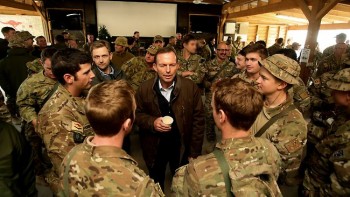Sitting on defence

$80,281,391.78
This is how much we will spend every single day this
year on defence. And this figure is conservative. It does not include
funds appropriated to the Defence Housing Authority, those administered
by Defence for military superannuation schemes and housing support
services, nor the additional funds provided directly to the Defence
Materiel Organisation to buy equipment. Equipment investment will grow
from around $3.5 billion last year to $6.1 billion this year.
This year’s federal budget was dominated by budget repair. Yet amid
the spending cuts and tax increases, Defence did very well. Nominal
defence spending will grow by $2.3 billion this financial year (2014-15)
to $29.3 billion, representing 1.8% of GDP. In real terms, the
year-on-year increase amounts to a 6% boost.
Tony Abbott has also promised to increase defence funding to 2% of
GDP in 2023-24. To meet the target on the basis of the funding
disclosed for the next four years, expenditure will have to increase at a
rate of 5.3% above inflation for the six years after that.
If the government wants to spend 2% of GDP on defence it’ll have to
find a way to convince taxpayers to accept the higher taxes and/or
reduced services necessary to fund the venture. Every extra dollar
allocated to Defence meant deeper cuts to social programs and higher
increases to taxes than would have otherwise been the case to achieve
its fiscal goals.
2% of projected GDP in 2023-24 is a lot of money; around $52 billion
($42 billion in today’s terms). Extrapolating current trends in
personnel and operating costs, there’ll be around $112 billion available
for capital investment in the forthcoming decade as a consequence,
compared with only $66 billion for the decade just past (both measured
in today’s dollars). It appears, therefore, that the ADF will need to
grow to accommodate the additional money that’s been promised.
Key initiatives in this budget included the bringing forward of $1.5
billion funding previously planned for 2017-18 to “address immediate
pressures”. I assume the ‘immediate pressures’ include the unending
search for the missing Malaysian plane on which we have already spent
about $50 million with another $90 million set aside for the search over
the next two years. They probably also include Scott Morrison’s war on
asylum seekers which is costing defence $60 million this year on top of
the $6 billion allocated to the Department of Immigration and Border
Protection.
Like other departments, defence has had an increase to the efficiency
dividend. Unlike other departments, according to the budget night
press release, ‘$1.2 billion in back office savings over the Forward
Estimates will be reinvested into Defence capability’.
On current estimates, each of Australia’s roughly 10 million workers
will be contributing around $5,000 a year each to sustain the promised
defence budget in 2023-24. Yet, according to opinion polls, support for
higher defence spending has fallen from 60% in 2001 to less than 40%
today.
Despite massive military spending the Australian Defence Force has a
wide range of serious problems and may have great difficulty defending
Australia in the near future.
Much of this relates to the attempts made by Liberal – Labor
governments to cast the ADF in the role of ‘Deputy Sheriff’ – a bit
player in distant US conflicts with limited independent capability.
New Australia
recommends that Australia maintain a ‘defensive only’ armed forces. This
does not threaten our neighbours and so will not trigger an arms race
with them. Maintaining a defensive-only force could save billions of
dollars and leave Australia better defended than it is at present with a
force oriented towards supporting US-led operations. They make the
following suggestions.
- Cancel the Joint Strike Fighter Program. Replace with far cheaper
and more capable aircraft such as F-15SE ‘Silent Eagle’ or Sukhoi Su-35
‘Super Flanker’. Savings up to ~$10 billion. - Discontinue Surface Combat Vessels. Surface naval combatants have
been obsolete for decades due to the ever-improving capability of
anti-ship missiles. Australia should cancel the new Destroyers, Frigates
& Corvettes and replace all vulnerable surface combat ships with
more survivable and cost-effective diesel-electric submarines. Savings:
Over ~$20 billion. - Cheaper Submarines. China recently bought eight ‘off the shelf’
super-stealthy diesel-electric Submarines for $US 1.6 billion while
Australia is considering spending $3 billion on each of its new
submarines. Australia should buy off-the-shelf submarines saving $1 – $2
billion each. - Cancel the Large Assault Ships. Instead of the slow and vulnerable
large assault ships Australia should buy the much cheaper and faster
Tasmanian-built INCAT catamarans. These are quite sufficient for
operations like helping East Timor. Savings: ~$1 billion.
The population of Australia represents 0.33 percent of the world´s
total population yet, in 2013, we provided 1.4% of the world’s total
military expenditure ($1.747 trillion). However, all this spending has
not bought us security. Because the spending is all on the wrong sorts
of equipment, Australia is becoming more vulnerable than ever before
according to some experts, including a former Defence Department
analyst, Liberal MP Dennis Jensen
who launched an extraordinary attack on the Abbott government’s
multibillion-dollar purchase of fighter jets, suggesting his colleagues
lacked the competency and the courage to stop the order.
I do not pretend to understand all the nuances of military
interaction around the world but it seems such a ridiculous waste of
resources.

No comments:
Post a Comment